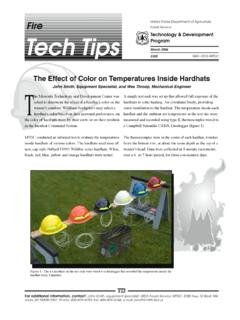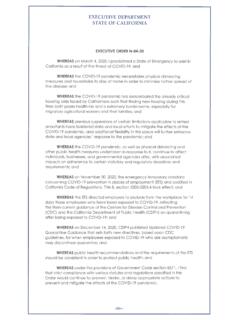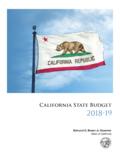Transcription of Standard fire behavior fuel models: a comprehensive set ...
1 United States Department of Agriculture Standard fire behavior fuel Forest Service Rocky Mountain Models: A comprehensive Research Station General Technical Set for Use with Rothermel's Report RMRS-GTR-153. June 2005. Surface fire Spread model Joe H. Scott Robert E. Burgan Abstract _____. Scott, Joe H.; Burgan, Robert E. 2005. Standard fire behavior fuel models: a comprehensive set for use with Rothermel's surface fire spread model . Gen. Tech. Rep. RMRS-GTR-153. Fort Collins, CO: Department of Agriculture, Forest Service, Rocky Mountain Research Station. 72 p. This report describes a new set of Standard fire behavior fuel models for use with Rothermel's surface fire spread model and the relationship of the new set to the original set of 13 fire behavior fuel models.
2 To assist with transition to using the new fuel models, a fuel model selection guide, fuel model crosswalk, and set of fuel model photos are provided. Keywords: fire behavior prediction, fire modeling, surface fuel , dynamic fuel model The Authors _____. Joe H. Scott has been a Forester with Systems for Environmental Management, a nonprofit research group based in Missoula, MT, since 1996. He is the lead developer of NEXUS, a system for assessing crown fire potential; lead developer of FireWords, an annotated, electronic glossary of fire science terminology; and codeveloper of FuelCalc, a system for computing, summarizing, and formatting ground, surface, and crown fuel characteristics from Standard inventory methods.
3 Scott has participated in several inves- tigations of surface and canopy fuel characteristics. He has a degree in forestry and resource management from the University of California at Berkeley and an degree in forestry from the University of Montana. Robert E. Burgan retired as a Supervisory Research Forester, Applications Team, fire behavior Research, Intermountain fire Sciences Laboratory, Missoula, MT. He was one of the developers of the 1978 National fire Danger Rating System and made the 1988. revisions of the 1978 NFDRS. Burgan developed the fuels portion of the BEHAVE fire behavior prediction system. He was the lead Forest Service scientist, working with scientists at the USGS EROS Data Center, to develop the greenness maps now used to assess fire potential nationally.
4 He was the lead scientist in developing a national 1-km resolution fuel model map from the Land Cover Characteristics Database provided by the EROS Data Center. He was the initial developer of the fire Potential Index and has worked closely with EROS Data Center scientists and others to improve and implement it. Acknowledgments _____ their reviews of the manuscript we also thank Patricia Andrews and Mark Finney, Missoula fire Sciences Lab;. We are grateful for thoughtful comments on the draft James K. Agee, University of Washington; Sam Sandberg, fuel model set or HTML application provided by: Collin FERA Pacific fire Sciences Lab; and Jennifer L.
5 Long, Bevins, Systems for Environmental Management; Systems for Environmental Management. Carlson, Oklahoma State University; Don Carlton, fire Photos to illustrate fuel models were provided by Program Solutions, LLC; Corky Conover, Sequoia Na- Roger Ottmar, Pacific fire Sciences Laboratory, Pacific tional Park; Wayne Cook, Washington Office fire Tech- Northwest Research Station; Bob Burgan, Missoula nology Transfer Program; Dave Engle, Oklahoma State fire Sciences Lab (retired); Joe Scott, Systems for University; Kato Howard, Alaska fire Service; Randi Environmental Management; and other published photo Jandt, Alaska fire Service; Paul Langowski, USFS Rocky guides.
6 Mountain Region; Duncan Lutes, Systems for Environ- Funding for the development of a new set of Standard mental Management; Melanie Miller, BLM (stationed at fire behavior fuel models and the preparation of this Missoula fire Sciences Lab); Rob Seli, Missoula fire document was provided by the LANDFIRE project, USDA. Sciences Lab; Dale Wade, Southern Research Station Forest Service, Rocky Mountain Research Station. This (retired); Dave Whitmer, Alaska fire Service; and Robert project was conducted under contract with Systems for Ziel, Michigan Department of Natural Resources. For Environmental Management, Missoula, MT.
7 You may order additional copies of this publication by sending your mailing information in label form through one of the following media. Please specify the publication title and number. Telephone (970) 498-1392. FAX (970) 498-1122. E-mail Web site Mailing Address Publications Distribution Rocky Mountain Research Station 240 West Prospect Road Fort Collins, CO 80526. Standard fire behavior fuel Models: A comprehensive Set for Use with Rothermel's Surface fire Spread model Joe H. Scott Robert E. Burgan Contents _____. Page Introduction .. 1. Need .. 2. Scope .. 3. Development .. 3. Characteristics .. 4. Naming Convention.
8 4. Dynamic fuel Models .. 6. Moisture Scenarios .. 8. fuel model Selection .. 8. fuel model Selection Guide .. 8. fuel model Crosswalks .. 12. fuel Models .. 17. fuel model Parameters .. 17. fuel Type Page .. 17. fuel model Page .. 19. Nonburnable fuel Type Models (NB) .. 19. Grass fuel Type Models (GR) .. 25. Grass-Shrub fuel Type Models (GS) .. 35. Shrub fuel Type Models (SH) .. 40. Timber-Understory fuel Type Models (TU) .. 50. Timber Litter fuel Type Models (TL) .. 56. Slash-Blowdown fuel Type Models (SB) .. 66. References .. 71. Standard fire behavior fuel Models: A comprehensive Set for Use with Rothermel's Surface fire Spread model Joe H.
9 Scott Robert E. Burgan Introduction _____. Predicting the potential behavior and effects of wildland fire is an essential task in fire management. Mathematical surface fire behavior and fire effects models and prediction systems are driven in part by fuelbed inputs such as load, bulk density, fuel particle size, heat content , and moisture of extinction. To facilitate use in models and systems, fuelbed inputs have been formulated into fuel models. A fuel model is a set of fuelbed inputs needed by a particular fire behavior or fire effects model . Different kinds of fuel models are used in fire science; this document addresses only fire behavior fuel models for use in the Rothermel (1972) surface fire spread model .
10 fire behavior fuel models are used as input to the Rothermel (1972) fire spread model , which is used in a variety of fire behavior modeling systems. The fire behavior fuel model input set includes: fuel load by category (live and dead) and particle size class (0 to inch, to inch, and to inches diameter). Surface-area-to-volume (SAV) ratio by component and size class Heat content by category Fuelbed depth Dead fuel moisture of extinction. The National fire Danger Rating System (NFDRS; Deeming and others 1977) uses Rothermel's (1972) spread model as its core. However, there are differences in the calculations that require the use of different fuel models than those for fire behavior prediction.












